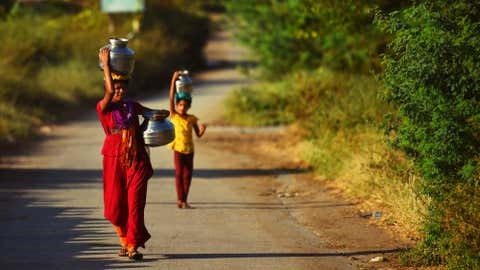Description

Disclaimer: Copyright infringement not intended.
Context
- A new UNICEF report titled 'The Climate Changed Child.' has been released.
- The report captured how the various climate and environmental shocks driven by climate change are impacting the lives of children.

Findings of the Report
Most affected children
- The largest share of affected children resides in the Middle East and North Africa and South Asia regions.
- In these areas, limited water resources, high seasonal variability, and risks of groundwater table decline or drought persist.
Water Security
- The report analyses three tiers of water security globally—water scarcity, water vulnerability, and water stress.
- Alarmingly, 436 million children face extreme water vulnerability, grappling with both high-water scarcity and low drinking water service levels, putting their lives, health, and well-being at risk.
- This extreme water vulnerability is a significant driver of preventable diseases, particularly among children under 5.
- The most affected children predominantly live in low- and middle-income countries in sub-Saharan Africa, Central and Southern Asia, and Eastern and South-Eastern Asia.
- In 2022, 436 million children were residing in areas experiencing extreme water vulnerability.
- Countries such as Niger, Jordan, Burkina Faso, Yemen, Chad, and Namibia are among the most impacted, with eight out of 10 children facing exposure.
Heatwave
- 559 million children are currently exposed to high heatwave frequency. This can impact all the 2.02 billion children globally by 2050. Around 470 million children, as of 2022, faced high or extremely high drought risk.
Floods
- The health of children is affected by extreme weather events like floods that are linked with climate change.
- Floods compromise safe water supply, damage sanitation facilities and occur in areas grappling with open defecation issues, leading to contamination of water. This can make way for outbreaks of diseases like diarrhoea.
Child malnutrition is worsened by crop failures and rising food prices, exacerbated by higher temperatures and increased rainfall linked to climate change.

Closing Remarks
- This year, UNICEF is launching the Sustainability and Climate Action Plan, which commit to galvanising efforts to fill global gaps to protect the most vulnerable children.
- The report asserted that confronting the planetary crisis for children requires a global movement of partnership.
- COP28 is a critical opportunity to finally put children on the climate change agenda.
- UNICEF called for embedding children and intergenerational equity in the Global Stocktake.
Global Stocktake is a process for countries and stakeholders to see where they are collectively making progress towards meeting the goals of the Paris Climate Change Agreement and where they are not.
- UNICEF also pitched for inclusion of children and climate-resilient essential services within the final decision on the Global Goal on Adaptation (GGA).
GGA collective commitment under Article 7.1 of the Paris Agreement is aimed at “enhancing” (the world’s) adaptive capacity, strengthening resilience, and reducing vulnerability to climate change.
- Ahead of COP28, the child rights body also called for making the Loss and Damage Fund and funding arrangements child-responsive. These, it hinted, could be made a reality with child rights embedded in the fund’s governance and decision-making process.
- The fund is aimed to provide financial assistance to countries most vulnerable and impacted by the effects of climate change and was a highlight at COP27.
|
PRACTICE QUESTION
Q. Climate Change has devastating consequences on children, affecting their physical and mental health. Putting children on the climate change agenda is imperative. Substantiate.
|













